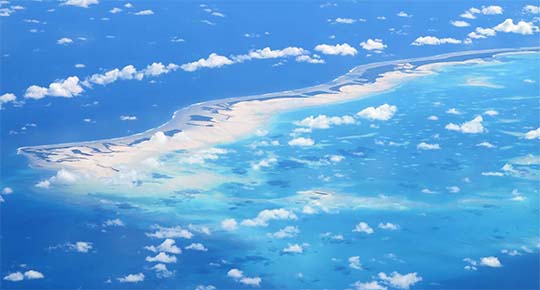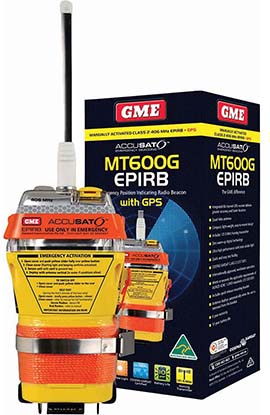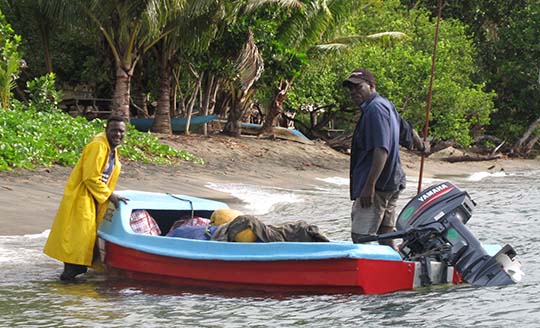Kiribati Missing Ship – 50 People, was there a A$369 EPIRB?
Sunday, 28 January 2018On January 18, the MV Butiraoi, a 17.5 metre catamaran ferry with 50 people on board set out from the Kiribati island of Nonouti on a two-day, 240km trip to the main island of the nation, South Tarawa. It never arrived and a New Zealand Air Force Orion aircraft has been sent to search for it.
 ▲ I spotted Nonouti as we were about to descend into South Tarawa from Fiji when I visited Kiribati in mid-November 2017.
▲ I spotted Nonouti as we were about to descend into South Tarawa from Fiji when I visited Kiribati in mid-November 2017.
◄ Did the vessel have a radio? Presumably not. Did anyone on board have a satphone? Presumably not again. OK, what about an EPIRB – an Emergency Position Indicating Radio Beacon? I guess not. In the west, the developing world, you’ll find an EPIRB on almost any modern vessel bigger than a rowboat. In the very worst case, the boat sinks, the EPIRB pops to the surface and starts yelling ‘help.’ I could buy one this afternoon for A$369 – that’s US$300 or £212. Not much for 50 lives is it?
A few years ago I crossed on an outboard-powered dinghy from Shortland Island in the north of the Solomon Islands to the southern end of Bougainville Island in Papua New Guinea. An international boat trip, albeit a very short one, in a boat without any radio contact or an EPIRB. There was a satphone on board, however. Mine. You can rent a satphone – equally useful for remote Australian outback trips as well as inter-island trips in the Pacific – for A$125 a week or A$300 month. I wrote about my concerns on Pacific Island small boat trips at the start of the Bougainville chapter in my book Dark Lands:
I’ve always had a nagging concern about the possibilities of ‘drifting away,’ the Pacific Island tendency to set off from Island A to Island B, in a small boat with an outboard motor only for things to go awry. Perhaps the motor fails or the fuel runs out. Perhaps they weren’t even planning a voyage, it was just a late afternoon fishing trip and when it came time to come home the motor wouldn’t start. Or a little rain squall blew through and when things cleared it was dark and come the dawn the island was nowhere in sight. They’d ‘lost the land,’ as one Pacific drifter I encountered put it.
I spent a couple of weeks in the islands of Tuvalu in 2001 and it seemed like every second islander had at some time ‘drifted away.’ Sometimes they only drifted for a few weeks before turning up on the French island of Wallis. Sometimes it was several months before they were rescued by a fishing trawler or, for one lucky drifter, a Greek cargo ship en route for a spell in dry dock in Japan. Laki (pronounced like Lucky) Salapu, who managed to drift away twice from late afternoon fishing trips, took six months to drift to American Samoa where he was initially arrested as a suspected illegal immigrant.
So it was not very encouraging to read a Solomons Star report a few weeks before my trip about 18 islanders who had drifted away on the same route I would soon be taking. They’d set off from southern Bougainville, where I intended to arrive, intending to get to Ghizo in a day, so in fact they were travelling rather further than my planned Shortland to Bougainville jaunt. They motored past Shortland, crossing the 100km or so of open ocean heading south, but as they approached Vella Lavella, just north of Ghizo, they ran out of fuel. For the next six days they drifted south and east, into the empty stretch of sea towards Papua New Guinea.
Fortunately a Taiwanese fishing boat spotted them, towed them close to Ghizo and gave them some fuel to get ashore. The paper reported that they had been given medical checkups and were ‘recovering.’ The Minister for Education & Human Resources, Dick Ha’amori, was worried about them, the paper continued, since his wife and three children were amongst the lucky voyagers.
‘We managed to eat mangoes we took from Bougainville and coconuts that floated on the sea,’ one of the survivors said.
 ▲ arriving safely in Bougainville.
▲ arriving safely in Bougainville.






